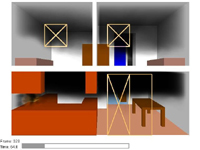Fighting fires in a burning building has no equal, but is it the only way to train? Is it the only way to demonstrate how different tactics will affect the fire? NIST has accepted the challenge of creating a virtual reality training

A simulated kitchen fire in a two story townhouse illustrating the newest visibility through smoke layer enhancements.
simulation of various fire situations to demonstrate how life-threatening conditions can develop in structures and to test firefighting tactics using computers. In turn, firefighters will have a tool that can provide realistic visualization of fire growth and suppression.
NIST experts are reworking their fire modeling software, Fire Dynamic Simulator (FDS), and the fire imaging program, Smokeview. Refinements of FDS will increase the system’s ability for simulating smoke and gas flow caused by fire, wind, ventilation and structural conditions. The upgrade also will improve data processing, resulting in speedier
calculations that will permit even the most complex fires (such as a multistory or multi-building event) to be portrayed.
NIST will be working with firefighter instructors to develop a simulation of all possible outcomes for selected fire scenarios used in training. These will be incorporated into a software package, enabling users to change a simulation with the click of a mouse. Instantly firefighters will be able to learn the consequences of their actions such as opening a window, closing a door or focusing a hose spray in a certain directions.
Enhancement of fire-related images, such as visibility through smoke, will add to the “real” feel.
To learn more about NIST’s current FDS and Smokeview software packages, see Understanding Fire and Smoke Flow Through Modeling and Visualization by G.P. Forney, D. Madrzykowski, K.B. McGrattan and L. Sheppard (PDF available HERE.) For more information on the virtual reality project, contact Dr. Glenn Forney, (1) + 301-975-2313 or gforney@nist.gov.
Designers and architects are seeking new ways to create a new indoor environment. One example is the Credit Valley Hospital/Carlo Fidani Peel Regional Cancer Centre in Mississauga, Canada designed by Farrow Partnership Architects, Inc. A treelike structure of exposed wood was to be created in the atrium in an effort to create a warm atmosphere; however, it did not meet the OBC (Ontario Building Code). An alternate material choice that would meet
the code requirements was steel, but it would not create the atmosphere sought by the designer. To provide fire protection for the wood structures in the atrium, a water mist system with the nozzles built into the lighting supports was proposed.
In order to gain approval for the mist system in the health care facility, a full-scale mock up of a portion of the design was constructed and tested by the National Research Council of Canada.
The wooden structure protected by water mist nozzles was subjected to a 7 m2 heptane pool fire. The test demonstrated that the flame spread was reduced and temperatures measured were well within acceptable limits. There was no evidence of flame attachment or soot deposition on the structure.
Although used in Europe for many years, water mist systems (also known as fog systems) are gaining popularity in North America. These systems do not need a large volume of water to suppress fires. The fine water mist quickly cools hot gasses, while the resulting steam displaces oxygen concentration; both working to suppress fires. Many different configurations of mist nozzles and pressurized water supply are available for applications.
The systems allow greater flexibility in design than traditional suppression systems.
To learn more about this project, a copy of the article in found at http://irc.nrc-cnrc.gc.ca/ircpubs or contact Sean Stanwick, seans@farrowpartnership.com.

Fire test of water mist spray protection.

Design
for atrium area
of the Peel Region Cancer Centre.